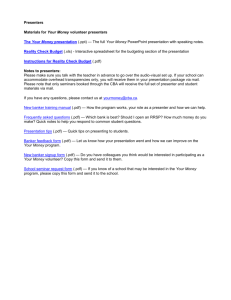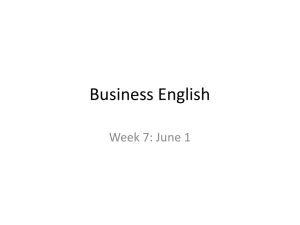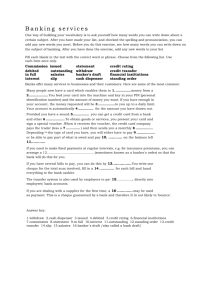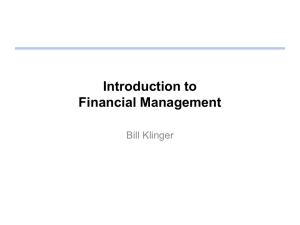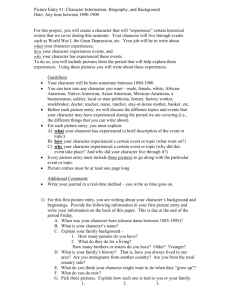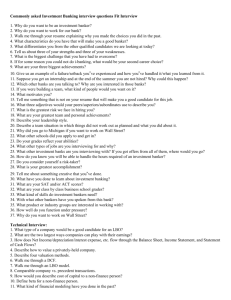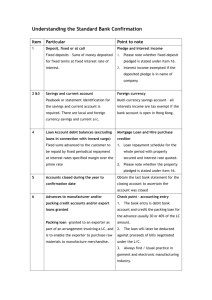The World Vision Trading Game
advertisement
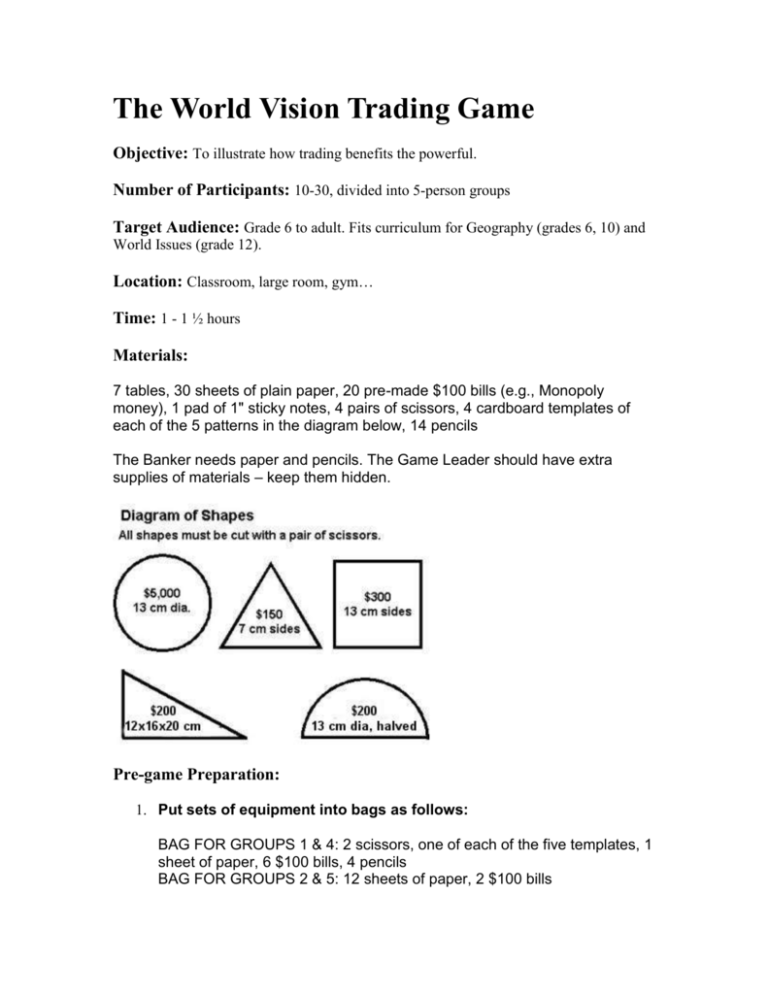
The World Vision Trading Game
Objective: To illustrate how trading benefits the powerful.
Number of Participants: 10-30, divided into 5-person groups
Target Audience: Grade 6 to adult. Fits curriculum for Geography (grades 6, 10) and
World Issues (grade 12).
Location: Classroom, large room, gym…
Time: 1 - 1 ½ hours
Materials:
7 tables, 30 sheets of plain paper, 20 pre-made $100 bills (e.g., Monopoly
money), 1 pad of 1" sticky notes, 4 pairs of scissors, 4 cardboard templates of
each of the 5 patterns in the diagram below, 14 pencils
The Banker needs paper and pencils. The Game Leader should have extra
supplies of materials – keep them hidden.
Pre-game Preparation:
1. Put sets of equipment into bags as follows:
BAG FOR GROUPS 1 & 4: 2 scissors, one of each of the five templates, 1
sheet of paper, 6 $100 bills, 4 pencils
BAG FOR GROUPS 2 & 5: 12 sheets of paper, 2 $100 bills
BAG FOR GROUPS 3 & 6: 4 sheets of paper, 2 $100 bills, 2 pencils
Alternatively, be creative with your own resource distribution!
2. Brief your Game Leader and Banker
Game Leader:
acts as the United Nations by attempting to be impartial and
intervening in disputes
keeps notes of transactions, interesting comments, and unfair
practices
is responsible for introducing new elements
Banker
keeps a record of each group's wealth
divides a sheet of paper into columns for each group, and when a
group brings shapes to the Banker, the Banker credits their column
with the appropriate amount
at the end of the game, adds the subtotals and announces them to
the groups
Procedure:
1. Divide the participants into 3 groups.
Teams 1 and 4 receive their bags and choose to represent an
industrialized country such as Canada, France, or Japan.
Teams 2 and 5 receive their bags and choose to represent a newly
industrialized country such as Brazil or India.
Teams 3 and 6 receive their bags and choose to represent a
developing country such as Tanzania, Bangladesh, or Honduras.
2. Write the objectives and rules of the game on a flipchart or overhead
transparency.
The objective of each country is to make as much wealth for itself as possible by
using the materials given to it. No other materials can be used. The wealth is
made by manufacturing paper shapes. The goods you are going to manufacture
are the shapes on the diagram of shapes (see below). Each shape has its own
value, as shown on the diagram. Give your manufactured shapes to the Banker in
batches of five or more for crediting to your bank account. You can manufacture
as many shapes as you have resources – the more you make, the wealthier you
will be.
Rule #1: All shapes must be cut by scissors, using the templates, and be
the exact size shown.
Rule #2: Use only the materials you have been given.
Rule #3: Physical force is not allowed.
Rule #4: The Game Leader represents the United Nations and will
intervene in any disagreements.
3. Announce that the manufacturing may begin. Allow for up to 45
minutes.
Notes for the Game Leader
Resist answering questions from the players. Simply repeat the rules if
necessary. Watch and record how groups negotiate prices and determine terms
of trade. Note any alliances, deals, cheating, or stealing – bring these to the
discussion at the end.
Do any or all of the following to stimulate activity:
1. Once the Banker has collected several shapes, change market values by
shouting out that the market value has dropped on one shape or risen for
another. Have the Banker note the new prices (for new transactions only,
not retroactive).
(For later discussion: Economies often rely on the export value of one
product. Example, when the world price of coffee fell due to oversupply,
the economies of Vietnam and many Latin American countries suffered.
Other reasons for dropping or rising prices are outdated vs. new
technology, and changes in consumer buying habits.)
2. Increase the supply of raw materials or technology by giving one group an
extra supply of any of the game items. Announce to the world that a new
deposit of raw material has been found.
(For later discussion: this parallels a country finding oil or an important
mineral, which can dramatically change a country's economic prospects.)
3. Send a discreet secret message (pre-written, with five sticky notes
attached) to all but one group, telling them that a given shape (e.g.,
triangle) will be worth double its value if they put a sticky note on it when
handing it in to the Banker. (Be sure to tell the Banker this!)
(For later discussion: this represents a country having a resource of which
it may not anticipate the full world market value. All the other countries do,
and so they make more of these resources to make huge profits.)
4. Be creative in adding your own stimuli. For example, break a large country
up ('civil war!') into two smaller ones, with most resources going to one of
the new groups. Or encourage a poor country to 'swarm' a smaller rich
country to take some of its resources. Or…
Debriefing the Game:
This game highlights unequal trading situations. The debriefing is the most
important part of the game, so be sure to leave at least 20 minutes for
discussion. Here are ways to help participants evaluate the game's proceedings:
Ask the Game Leader to list grievances documented during the game. Allow
the referenced groups or individuals to responde.
The game attempts to reflect real practices. Can participants list current
global examples?
Discuss reactions of various players while trading occurred.
Why weren't resources shared more freely?
How would cooperation have affected trading?
Describe how alliances formed (if any). What were the results?
This game was adapted by World Vision, with permission, from the "It's Not Fair"
handbook, Christian Aid, London, England. Further changes have been made by
Terry Newcombe, an Oxfam Canada volunteer.
